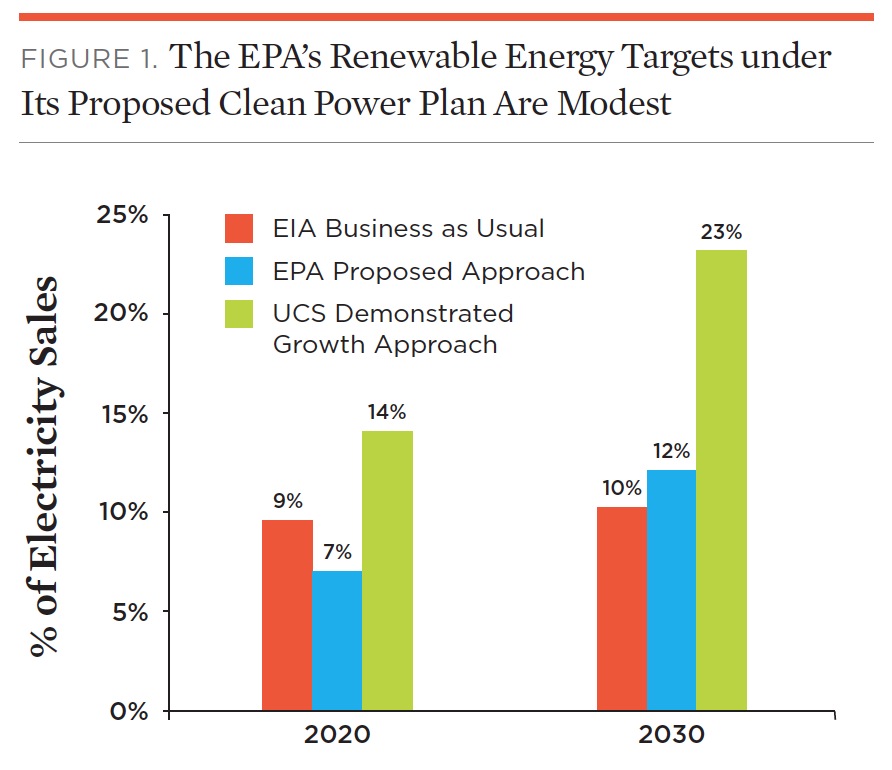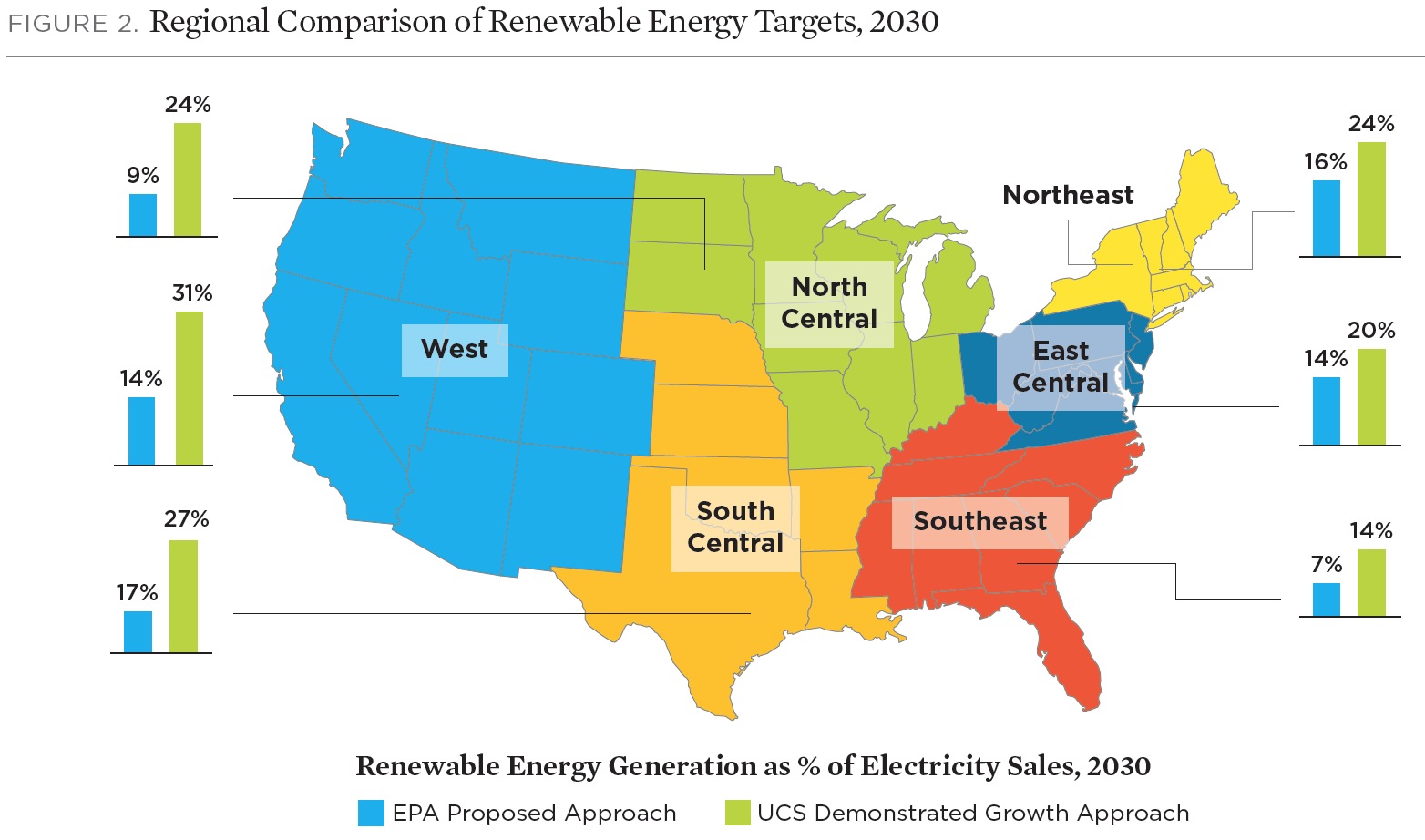UNION OF CONCERNED SCIENTISTS
Increasing renewable energy use will achieve greater emissions reductions
 In June 2014, the U.S. Environmental Protection Agency (EPA) proposed in its Clean Power Plan the first-ever limits on carbon dioxide (CO2) produced by existing power plants. These plants are responsible for nearly 40 percent of total U.S. CO2 emissions, constituting the nation’s largest source of this heat-trapping gas. Given that Americans face worsening risks of climate impacts, as clearly reported in the National Climate Assessment, the Clean Power Plan is an important step forward in the effort to limit those risks (Melillo, Richmond, and Yohe 2014). The plan sets emissions rate reduction targets for the power sector state by state, and it would reduce national electricity sector emissions by an estimated 30 percent below 2005 levels by 2030 (EPA 2014a). However, analysis of the rule by the Union of Concerned Scientists (UCS) shows that the Clean Power Plan could deliver much deeper reductions in emissions, especially by taking greater advantage of cost-effective renewable energy options.
In June 2014, the U.S. Environmental Protection Agency (EPA) proposed in its Clean Power Plan the first-ever limits on carbon dioxide (CO2) produced by existing power plants. These plants are responsible for nearly 40 percent of total U.S. CO2 emissions, constituting the nation’s largest source of this heat-trapping gas. Given that Americans face worsening risks of climate impacts, as clearly reported in the National Climate Assessment, the Clean Power Plan is an important step forward in the effort to limit those risks (Melillo, Richmond, and Yohe 2014). The plan sets emissions rate reduction targets for the power sector state by state, and it would reduce national electricity sector emissions by an estimated 30 percent below 2005 levels by 2030 (EPA 2014a). However, analysis of the rule by the Union of Concerned Scientists (UCS) shows that the Clean Power Plan could deliver much deeper reductions in emissions, especially by taking greater advantage of cost-effective renewable energy options.
This brief outlines a better way to make the most of renewable energy in the Clean Power Plan, and to strengthen its state renewable energy targets as the cost of sources such as wind and solar power decline. The UCS proposal builds on the EPA’s approach while utilizing the latest available market data, demonstrated rates of growth in renewable energy, and existing state commitments to deploy renewables. Using our recommended modifications, the EPA could nearly double the amount of cost-effective renewable energy in their state targets—from 12 per-cent of total 2030 U.S. electric sales to 23 percent (Figure 1, p. 3).
The EPA should adopt a similar approach, and thereby increase the total emissions reductions achieved by the Clean Power Plan from 30 percent below 2005 levels by 2030 to approximately 40 percent. Strengthening other parts of the plan could help achieve even deeper reductions.
The Basics of the Clean Power Plan
The EPA draft Clean Power Plan establishes state-by-state emissions rate reduction targets, and it offers a flexible framework under which states may meet those targets. The rule provides for a number of options to cut carbon—called “building blocks”—and determines state emissions rate targets by estimating the extent to which states can take advantage of each of them. Renewable energy resources account for one of the building blocks, alongside efficiency improvements at individual fossil fuel plants, nuclear power, shifting generation from coal to natural gas, and greater energy efficiency in buildings and industries. The EPA determined these building blocks to be the best system of emission reduction (BSER) for existing power plants—a technological and economic regulatory determination required by the Clean Air Act (CAA).
Each state’s target derives from the aggregate level of emissions rate reductions coming from the suite of building blocks. Thus assumptions made by the EPA about the emissions reduction potential of each building block in a state directly affect its overall target. If the EPA’s assessment for any of the individual building blocks is too modest, so too will be the state’s final target.
Targets differ across states because of each state’s unique mix of electricity-generation resources—and also because of technological feasibilities, costs, and emissions reduction potentials of each building block, all of which vary across the country. Because states are free to combine any of these building blocks in a flexible manner, they could therefore opt to meet a much larger share of their overall target through expanding their use of renewable energy resources.
The EPA’s decision to include renewable energy as an eligible compliance option for states is sensible, as technologies such as wind and solar—which already deliver safe, reliable, and affordable power to millions of U.S. consumers—emit no carbon in their operation and are a viable alternative to fossil fuels. All states have significant and diverse renewable energy resource potential that can be developed. And as a result of falling costs, advances in technology, and strong state policies, renewable energy technologies are in a strong position to compete with the other emissions reduction strategies allowed under the Clean Power Plan.
Download full version (PDF): Strengthening the EPA’s Clean Power Plan
About the Union of Concerned Scientists
www.ucsusa.org
The Union of Concerned Scientists is the leading science-based nonprofit working for a healthy environment and a safer world. UCS combines independent scientific research and citizen action to develop innovative, practical solutions and to secure responsible changes in government policy, corporate practices, and consumer choices.
Tags: CAA, Clean Air Act, Environmental Protection Agency, EPA, Union of Concerned Scientists







 RSS Feed
RSS Feed